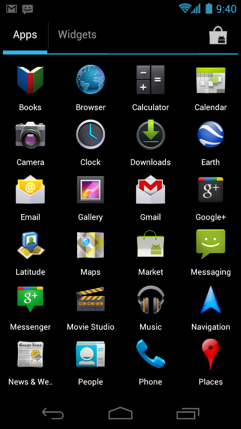
At a special event in Hong Kong on Wednesday, Samsung and Google jointly announced the Galaxy Nexus and unveiled Android 4, codenamed Ice Cream Sandwich (ICS), the next major version of Google's mobile operating system. The hardware specs are impressive and the platform update offers some compelling new features.
Google first announced plans for ICS during its Google I/O conference back in May. The search giant said that the update would likely come in the fourth quarter and that it would bring together the Android tablet and smartphone environments in a cohesive user experience. The big unveiling was expected to take place alongside CTIA earlier this month, but was pushed back to this week and relocated in Hong Kong alongside the AsiaD conference.
Samsung started the press event by unveiling the Galaxy Nexus, an impressive new smartphone that the consumer electronics company codeveloped with Google to serve as the ICS launch device. Rumors about the device's lofty specs have been circulating for months. The highlight is its 4.65-inch Super AMOLED display with an impressive 1280x720 resolution. The device has a curved form factor that is said to give it a natural feel despite its large size.
The device also has a 1.2GHz dual-core TI OMAP4 CPU, front and rear-facing cameras and 1GB of RAM. Samsung says that there will be separate models with HSPA+ and LTE connectivity available depending on region. Other connectivity features include Bluetooth, WiFi, and NFC. It also has the full array of sensors, including a built-in gyroscope and barometer. The device is scheduled to ship in November with Android 4 on board.
After Samsung unveiled the phone, Google's chief Android team members—including Andy Rubin and Matias Duerte—demonstrated the new features and user interface of Android 4. The much-anticipated software update brings many of Honeycomb's features to the smartphone form factor.

The standard physical back, home, search, and menu buttons that have historically adorned the front of Android handsets are being replaced by more flexible on-screen equivalents. The Android home screen got a major overhaul that brings support for resizeable widgets and an improved dock area.
The slick scrollable multitasking interface from Android 3.1 is a standard part of ICS. Just like in Honeycomb, it has been given a persistent soft button so that it will be more easily discoverable than the task switching interface has historically been on Android phones. A particularly nice addition to Android's multitasking feature set in ICS is support for closing an application by swiping its thumbnail off the screen, much like in webOS. It's not clear yet if that actually terminates the process or just removes it from the multitasking list.
Google's standard voice-enabled keyboard system got a particularly impressive boost: speech transcription is now done in real-time with very little latency. The system will convert words to text as they are spoken instead of waiting until the user stops speaking. That represents a step up from the voice keyboard functionality that Apple introduced in iOS 5.
Another intriguing addition to the operating system is support for face detection and tracking. Google demoed some of its early work on that technology back at Google I/O, but now it's fully baked into the platform. ICS offers optional support for using face recognition to unlock the device. Although that feature is compelling in theory, it failed to work properly during the demonstration, which suggests that it might be sensitive to certain lighting conditions.
The camera software also appears to have received some major improvements in ICS. Google touted the extremely fast shutter speed during its on-stage demo. It's not entirely clear, however, how much of that is attributable to the software versus the Galaxy Nexus camera. It has a "continuous" autofocus feature that will ensure that pictures snapped in rapid succession will remain clear. The new image gallery program has built-in editing tools and filters so that photos can be modified on the device itself.
Other features that were presented during the event include support for sharing links between devices via NFC, a new GMail client implementation with a much-improved user interface, support for visual voicemail, an improved addressbook with social network integration, a tool that allows users to track data consumption on a per-application basis, and a new font.
Google revealed that the ICS developer SDK will be made available immediately, which means that developers will be able to start working on updating their applications to take advantage of the new functionality. The availability of source code was not discussed during the event, however. It's not yet clear when or if the ICS source code will be published. Assuming Google releases the code this time around, it probably won't happen until after the Galaxy Nexus ships. It's also not yet clear if the new version of the platform will be rolled out to older devices.
Listing image by Photograph by Google
reader comments
211